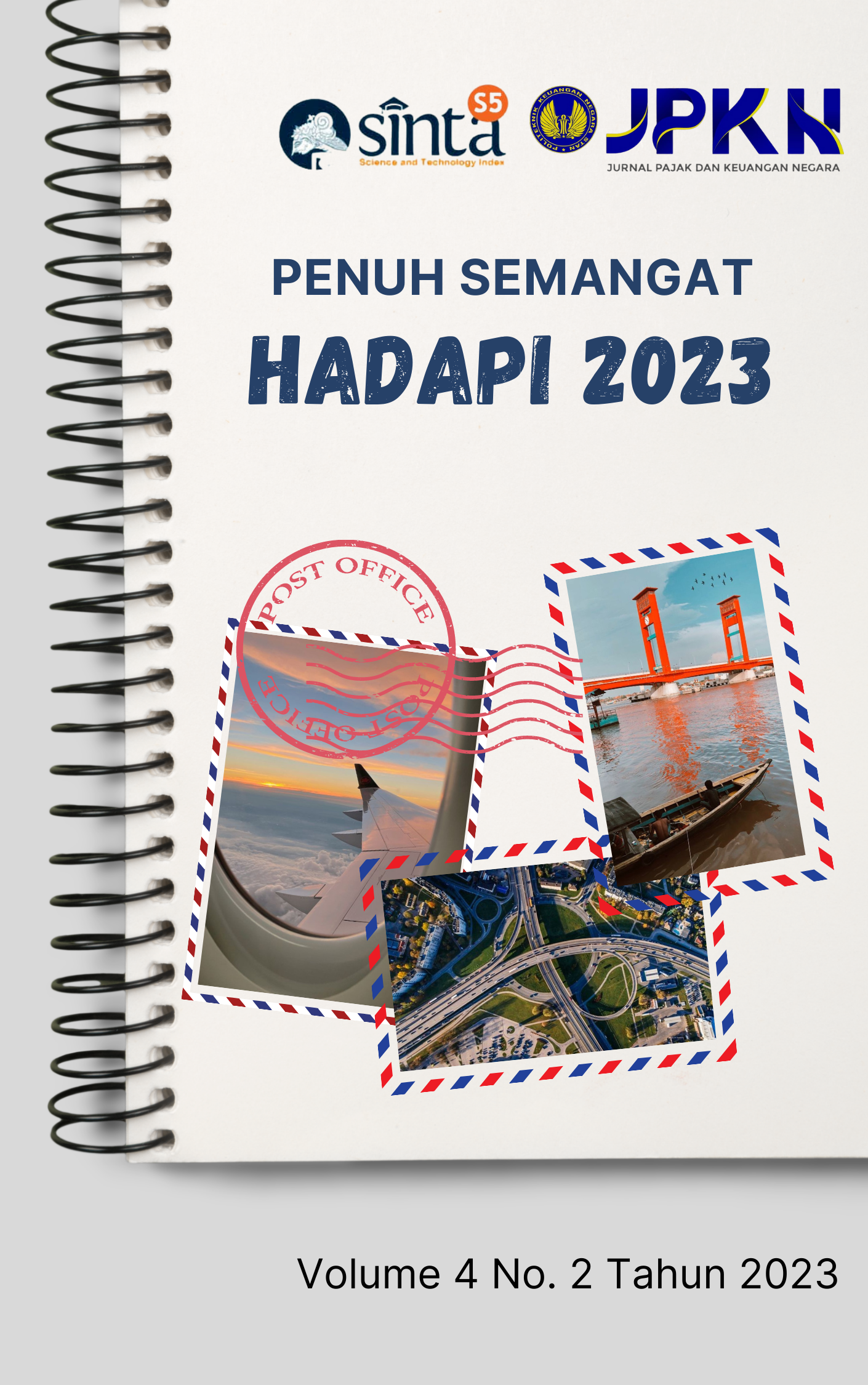The Effect Of Public Service Motivation And Love Of Money On Employee Innovative Work Behavior
DOI:
https://doi.org/10.31092/jpkn.v4i2.2030Keywords:
Civil servants, Innovative work behavior, Love of money, Public service motivationAbstract
This study aims to examine the impact of public service motivation and love of money on innovative work behavior on work units at the Directorate General of Taxation, Ministry of Finance of the Republic of Indonesia. The research strategy for this study is a quantitative method with a survey as a data collection tool. The data sampling method is non-probability sampling with purposive sampling technique. The sample size is 254 respondents. Respondents are those who have status as Civil Servants in the Directorate General of Taxation and the minimum work period is 2 years. Data analysis using Partial Least Square - Structural Equation Model (PLS-SEM). The results of this study indicate that public service motivation and love of money have a positive effect on innovative work behavior.
References
Bos-Nehles, A., Renkema, M., & Janssen, M. (2017). HRM and Innovative Work Behavior: A Systematic Literature Review. Personal Review, 46(7), 1228–1253.
De Vries, H., Bekkers, V. J. J. M., & Tummers, L. G. (2015). Innovation in the public sector: a systematic review and future research agenda. Public Administration, 94(1), 146–166.
Dirhantoro, T. (2020). PNS Dirjen Paja Paling Besar Dapat Tunjangan Tertinggi Sampai Ratusan Juta, Berikut Rinciannya. Retrieved April 20, 2021, from Kompas TV website: https://www.kompas.tv/article/132156/pns-dirjen-pajak-paling-besar-dapattunjangan-tertinggi-sampai-ratusan-juta-berikut-rinciannya?page=all
Eisenberger, R. (1992). Learned industriousness. Psychological Review, 99(2), 248–267.
Eisenberger, R., & Rhoades, L. (2001). Incremental effects of reward on creativity. Journal of Personality and Social Psychology, 81(4), 728–741.
Eisenberger, R., & Shanock, L. (2013). Rewards, intrinsic motivation, and creativity: a case study of conceptual and methodological isolation. Creativity Research Journal, 15(2–3), 121–130.
Furnham, A., & Argyle, M. (1998). The Psychology of Money. London: Routledge.
Gagne, M., & Deci, E. L. (2005). Self-determination theory and work motivation. Journal of Organizational Behavior, 26(4), 331–362.
Gupta, N., & Shaw, J. D. (1998). Let The Evidence Speak: Financial Incentives Are Effective ! Compensation and Benefits Review, 26, 28–32.
Herzberg, F. (1987). One more time: how do you motivate employees ? Harvard Business Review, September-, 109–200.
Hsieh, C. W. (2018). No one can two masters: revisiting effect of love money and public service motivation on job satisfaction. Public Performance and Management Review, 41(4), 745–767.
Jacobson, W. S. (2011). Creating a Motivated Workforce: How Organizations Can Enhance and Develop Public Service Motivation (PSM). Public Personnel Management, 40(3), 215–238.
Janssen, O. (2000). Job demands, perceptions of effort-reward fairness, and innovative work behavior. Journal of Occupational and Organizational Psychology, 73(3), 287–302.
Kanter, R. M. (1988). Three tiers for innovation research. Communication Research, 15(5), 509–523.
Kanter, R. M. (2013). Three Things that Actually Motivate Employees. Harvard Business Review. Retrieved from https://hbr.org/2013/10/three-things-that-actually-motivate-employees
Lembaga Administrasi Negara. (2021). Kepala LAN Ajak Pimpinan Sektor Publik Lebih Kreatif di Masa Pandemi. Retrieved November 6, 2021, from lan.go.id website: https://lan.go.id/?p=4831
Liâ€Ping Tang, T., Furnham, A., & Meiâ€Tzu Wu Davis, G. (2002). The meaning of money. Journal of Managerial Psychology, 17(7), 542–563.
Liu, B. C., & Tang, T. L. P. (2011). Does the love of money moderate the relationship between motivasi pelayana npublik and job satisfaction? The case of Chinese professionals in the public sector. Public Administration Review, 71(5), 718–727.
Liu, B., Zhang, X., Du, L., & Hu, Q. (2015). Validating the construct of public service motivation in for-profit organizations: a preliminary study. Public Management Review, 17(2), 262–287.
Mitchell, T. R., & Mickel, A. E. (1999). The meaning of money: an individual-difference perspective. Academy of Management Review, 24(3), 568–578.
Perry, J. L. (1996). Measuring Public Service Motivation: An Assessment of Construct Reliability and Validity. Journal of Public Administration Research and Theory, 6(1), 5–22.
Perry, J. L., & Wise, L. . (1990). The motivational bases of public service. Public Administration Review, 50(3), 367–373.
Rainey, H. G. (1982). Reward preference among public and private managers: in search of the service ethic. American Review of the Public Administration, 16(4), 288–302.
Susanto, E. (2020). Does Love of Money Matter For Innovative Work Behavior In Public Sector Organizations? Evidence From Indonesia. International Journal of Public Sector Management, 34(1), 71–85.
Tang, T. L.-P. (2008). To Help or Not to Help? The Good Samaritan Effect and the Love of Money on Helping Behavior. Journal of Business Ethics, 82, 865–887.
Tang, T. L.-P., Tillery, R. ., Lazarevski, B., & Luna-Arocas, R. (2004). The Love of Money and Work-Related Attitudes. Journal of Managerial Psychology, 19(5), 542–548.
Tang, T. L. P. (1992). The meaning of money revisited. Journal of Organizational Behavior, 13(2), 197–202.
Tang, T. L. P., & Chiu, R. K. . (2003). Income, money ethic, pay satisfaction, commitment, and unethical behavior: is the love of money the root of evil for Hong Kong employees ? Journal of Business Ethics, 46(1), 13–30.
Tempo.Co. (2015). Ini Alasan Mengapa Gaji Pegawai Pajak Lebih Tinggi. Retrieved April 21, 2021, from bisnis.tempo.co website: https://bisnis.tempo.co/read/643438/ini-alasan-mengapa-gaji-pegawai-pajak-lebih-tinggi/full&view=ok
Vandenabeele, W. (2007). Toward a public administration theory of public service motivation: an institutional approach. Public Management Review, 9(4), 545–556.
Vogel, D., & Kroll, A. (2016). The Stability And Change Of PSM-related values across time:Testing theoretical expectations against panel data. International Public Management Journal, 19, 53–77.
Yamauchi, K. T., & Templer, D. I. (1982). The development of a money attitude scale. Journal of Personality Assessment, 6(5), 522–528.
Yuan, F., & Woodman, R. W. (2002). Innovative Behavior In The Workpalce:The Role Of Performance And Image Ourcome Expectation. Academy Of Management Journal, 53(2), 323–342.
Zhou, Y., Zhang, Y., & Montoro-Sanchez, A. (2011). Utilitarianism Of Romanticism: the effect of rewards on employees’ innovateve behavior. International Journal Of Manpower, 32(1), 81–98.
Downloads
Published
How to Cite
Issue
Section
License
Copyright (c) 2023 Sarah Ditta

This work is licensed under a Creative Commons Attribution 4.0 International License.

This work is licensed under a Creative Commons Attribution 4.0 International License.







